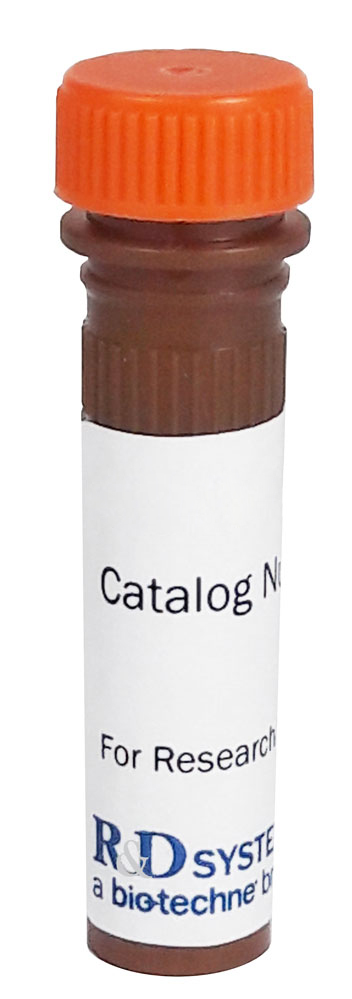Human/Mouse Proinsulin Alexa Fluor® 594-conjugated Antibody Summary
Phe25-Asn110
Accession # P01308
Applications
Please Note: Optimal dilutions should be determined by each laboratory for each application. General Protocols are available in the Technical Information section on our website.
Reconstitution Calculator
Preparation and Storage
Background: Proinsulin
Proinsulin is synthesized as a single chain, 110 amino acid (aa) preproprecursor that contains a 24 aa signal sequence and an 86 aa proinsulin propeptide. Following removal of the signal peptide, the proinsulin peptide undergoes further proteolysis to generate mature insulin, a 51 aa disulfide-linked dimer that consists of a 30 aa B chain (aa 25‑54) bound to a 21 aa A chain (aa 90‑110). The 34 aa intervening peptide (aa 55‑89) that connects the B and A chains is termed the C-peptide. Human proinsulin shares 84% and 80% aa sequence identity with rat and bovine proinsulin, respectively. Most of the sequence variation between species occurs in the region of the C-peptide (1). This peptide generates a structural conformation that allows for the correct formation of the intrachain disulphide bonds (1). Insulin is a molecule that facilitates the cellular uptake of glucose. This is accomplished by regulating the appearance of membrane glucose transporters. Low insulin levels or lack of insulin are associated with type 2 and type 1 diabetes mellitus, respectively. These conditions are associated with an increased risk for microvascular complications such as retinopathy, nephropathy, and peripheral neuropathy (3). Proinsulin also circulates, but its physiologic role is less well understood. It does possess about 25% of the activity of mature insulin, but it would seem unlikely to be a natural substitute for insulin (4). In type 2 diabetes, an elevated proinsulin to insulin ratio in the circulation is a well-known abnormality (5‑9). Perhaps this abnormality represents either compromised proteolytic processing or a general inability to process increased levels of insulin precursor (5). In any event, proinsulin will stimulate amylin secretion by beta -cells, and amyloid formation in pancreatic islets that promotes decreased beta cell function (10). Studies also suggest that fasting serum proinsulin may be a better predictor of future type 2 diabetes than fasting insulin levels in obese children (11).
- Bell, G.I. et al. (1980) Nature 284:26.
- Barbetti, F. et al. (1990) J. Clin. Endocrinol. Metab. 71:164.
- Forst, T. et al. (2008) Exp. Diabetes Res. 2008:176245.
- Steffes, M.W. et al. (2003) Diabetes Care 26:832.
- Roder, M.E. et al. (1999) Diabetes Care 22:609.
- Porte, D. Jr. (1991) Diabetes 40:166.
- Gordon, P. et al. (1974) Diabetologia 34:483.
- Saad, M.F. et al. (1990) J. Clin. Endocrinol. Metab. 70:1247.
- Roder, M.E. et al. (1995) J. Clin. Endocrinol. Metab. 80:2359.
- Dworacka, M. et al. (2006) Int. J. Clin. Pharmacol. Ther. 44:14.
- Kamoda, T. et al. (2006) Diabetes Obes. Metab. 8:192.
Product Datasheets
Product Specific Notices
This product is provided under an agreement between Life Technologies Corporation and R&D Systems, Inc, and the manufacture, use, sale or import of this product is subject to one or more US patents and corresponding non-US equivalents, owned by Life Technologies Corporation and its affiliates. The purchase of this product conveys to the buyer the non-transferable right to use the purchased amount of the product and components of the product only in research conducted by the buyer (whether the buyer is an academic or for-profit entity). The sale of this product is expressly conditioned on the buyer not using the product or its components (1) in manufacturing; (2) to provide a service, information, or data to an unaffiliated third party for payment; (3) for therapeutic, diagnostic or prophylactic purposes; (4) to resell, sell, or otherwise transfer this product or its components to any third party, or for any other commercial purpose. Life Technologies Corporation will not assert a claim against the buyer of the infringement of the above patents based on the manufacture, use or sale of a commercial product developed in research by the buyer in which this product or its components was employed, provided that neither this product nor any of its components was used in the manufacture of such product. For information on purchasing a license to this product for purposes other than research, contact Life Technologies Corporation, Cell Analysis Business Unit, Business Development, 29851 Willow Creek Road, Eugene, OR 97402, Tel: (541) 465-8300. Fax: (541) 335-0354.
FAQs
No product specific FAQs exist for this product, however you may
View all Antibody FAQsReviews for Human/Mouse Proinsulin Alexa Fluor® 594-conjugated Antibody
There are currently no reviews for this product. Be the first to review Human/Mouse Proinsulin Alexa Fluor® 594-conjugated Antibody and earn rewards!
Have you used Human/Mouse Proinsulin Alexa Fluor® 594-conjugated Antibody?
Submit a review and receive an Amazon gift card.
$25/€18/£15/$25CAN/¥75 Yuan/¥2500 Yen for a review with an image
$10/€7/£6/$10 CAD/¥70 Yuan/¥1110 Yen for a review without an image


